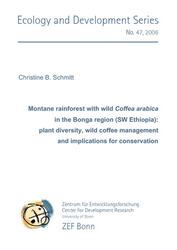| Areas | |
|---|---|
| Serie de libros (96) |
1378
|
| Nachhaltigkeit |
3
|
| Gesundheitswesen |
1
|
| Letra |
2364
|
| Ciencias Naturales |
5406
|
| Matemática | 229 |
| Informática | 319 |
| Física | 980 |
| Química | 1363 |
| Geociencias | 131 |
| Medicina humana | 243 |
| Estomatología | 10 |
| Veterinaria | 108 |
| Farmacia | 147 |
| Biología | 835 |
| Bioquímica, biología molecular, tecnología genética | 121 |
| Biofísica | 25 |
| Nutrición | 45 |
| Agricultura | 1004 |
| Silvicultura | 201 |
| Horticultura | 20 |
| Ecología y conservación de la tierra | 148 |
| Ciencias Ingeniería |
1793
|
| General |
98
|
|
Leitlinien Unfallchirurgie
5. Auflage bestellen |
|
Erweiterte Suche
Montane rainforest with wild Coffea arabica in Bonga region (SW Ethiopia): plant diversity, wild coffee management and implications for conservation (Tienda española)
Christine B. Schmitt (Autor)Previo
Indice, Datei (44 KB)
Lectura de prueba, Datei (190 KB)
The montane rainforests of Ethiopia are the center of origin and genetic diversity of Coffea arabica L. (Rubiaceae). They form part of the Eastern Afromontane biodiversity hotspot due to the high threat of deforestation. Concepts for conservation of these forests and their wild coffee populations are urgently needed. For the present study, vegetation surveys were carried out in four forest fragments in the Bonga region (southwestern Ethiopia) situated between 1,560 and 2,280 m asl. A total of 309 vascular plant species including 16 endemics were recorded; 36 % of the species occur in all forest fragments, while 43 % are present in one fragment only. Ordination methods reveal that plant species composition is strongly influenced by the altitudinal gradient. The forest fragment Koma, which is located above 1,800 m asl, is characterized by high pterophyte diversity and high abundance of Afromontane endemics or near endemics. Forest below 1,800 m asl has a greater diversity of tree species and pytogeographical elements, and is further divided in a moister type (Mankira forest fragment) and a drier type (Kayakela forest fragment).
Many species of the understory are frequent and abundant, so that the representative species number for a forest fragment can be captured with 10 study plots. In contrast, many tree species and epiphytes have low frequency, and the recording of their representative species number in a forest fragment requires 29 study plots. Wild coffee grows throughout the forest until 2,050 m asl except for extremely shaded and humid sites. Growth rates are very low, in particular during the main rainy season from July until October. Most wild coffee populations are utilized by local farmers. Three use types can be differentiated: (1) Unmanaged wild coffee has very low density in the shaded understory of undisturbed forest. Yields (clean coffee) are below 5 kg ha-1 a-1. (2) Forest coffee systems with low management intensity have an undisturbed forest structure, but some undergrowth vegetation is removed systematically. Abundance and size of coffee trees increase, and yields can reach 15 kg ha-1 a-1. (3) In semi-forest coffee systems, management intensity is high and forest structure is disturbed. Most undergrowth vegetation besides coffee is cleared at least once a year and some canopy trees are cut. Removal of competing plants and increased light penetration stimulate wild coffee growth. Yields average 35 kg ha-1 a-1. Low management intensity in forest coffee systems does not modify natural species composition. Abundance and distribution of tree species in unmanaged forest and forest coffee systems are currently governed by natural dynamics, but increasing demand for wood is likely to cause over-exploitation of some highly valued secondary forest and climax tree species.
In semi-forest coffee systems, slashing of vegetation and related modification of forest microclimate have a strong impact on species composition and species population structures. Most mature individuals of woody species are coppiced, which favors species that regenerate well vegetatively. Species richness increases due to high numbers of ruderal herbs, climbers and pioneer species adapted to regeneration in disturbed sites. In contrast, the number and abundance of typical forest species that require shade and humidity decline. This is most pronounced regarding tree species. This study makes suggestions for a conservation concept that combines both protection of the original plant diversity of Afromontane forest and profitable use of wild coffee.
| ISBN-10 (Impresion) | 3867270430 |
| ISBN-13 (Impresion) | 9783867270434 |
| ISBN-13 (E-Book) | 9783736920439 |
| Formato | A5 |
| Idioma | Inglés |
| Numero de paginas | 186 |
| Laminacion de la cubierta | Brillante |
| Edicion | 1 |
| Serie | ZEF Bonn |
| Volumen | 0 |
| Lugar de publicacion | Göttingen |
| Fecha de publicacion | 30.10.2006 |
| Clasificacion simple | Tesis doctoral |
| Area |
Agricultura
|








